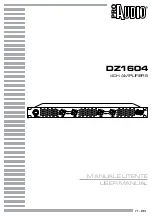
9
The following information is provided for reference only. Please consult a professional if unsure
about any aspects of commercial or residential installations.
SPEAKER CONNECTION
The rear panel of the amplifier contains 5, zoned speaker connections.
BE SURE TO CONNECT SPEAKERS PROPERLY, see line voltage instructions below.
The speaker lines are to be connected directly between the appropriate COM terminal on the terminal
strip and the terminal corresponding to the impedance of the speaker(s).
Connect the cables to the terminals on the screw terminal strip provided. Use the screw terminals which
correspond to the proper polarity of the speaker(s). One lead must always be connected to the COM.
IMPORTANT NOTICE:
When 70V constant line voltages are used, a line matching transformer must be
used with each speaker. All transformers must be connected in parallel.
ALWAYS CONNECT LINE TRANSFORMERS IN PARALLEL, NEVER CONNECT IN SERIES
SPEAKER IMPEDANCES
Speaker terminal taps for 70V constant line voltage are provided on the rear panel of the unit. To connect
the power output directly to a speaker or PA horn or a combination of speakers and/or PA horns, con-
nect to the COM and (+) terminal on the strip. Be sure the speaker(s) or PA horn(s) can handle a reason-
able power output from the amplifier or permanent damage to the speaker(s) or PA horn(s) may result.
Also, be careful not to overload the amplifier with too many speakers or PA horns. If it is desired to use
a number and variety of speakers, the speakers must be arranged in various series or parallel arrays to
provide proper impedance matching. 70V constant line voltage must be used (parallel connection only).
If you are not familiar with impedance matching, consult a professional installer or technician for advice.
If 70V constant line voltages are used, a line matching transformer must be used with each speaker.
Again do not overload or use incompatible speakers. Line transformers are the preferred method for
multi-speaker installation.
CABLE REQUIREMENTS
Output cabling need not be shield in most case and should be of sufficient gauge to minimize losses due
to the
resistance of the wire over long runs (insertion loss). Cable thinner than 18 gauge AWG is not recom-
mended. Long runs require 16 gauge AWG or heavier.
In some cases where the output cable is run in close proximity to unshielded intercom cables, electrical
cables, radio transmission antennas or other sources of interference, or when the amplifier is being used
for paging from a telephone system, the amplifier may require shielded output cabling to prevent audio
feedback or interference.
PRIORITY PAGE
The amplifier features a voice activated priority page circuit and automatically mutes all program material
(Auxiliary, Module, Microphone, etc.) from the amplifier’s output, and permits MIC 1 and the TEL input to
override for paging announcements.
SECTION 3: REFERENCE INFORMATION






























